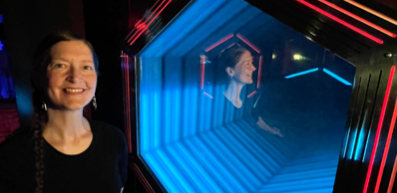
Liza Bender (she/her) was born and raised in Anchorage, Alaska and currently lives in the Bay Area of San Francisco, CA. She has derived a blend of inspirations from both locations that weave themselves into her creative works and collaborations. Liza is curious about the relationships between the natural world, technology and the human experience; specifically of their juxtapositions, influences and symbiotic relationships. From a young age Liza has been led by curiosity, improvisation and has used multiple creative arts mediums to express herself and discover the richness of being human; it is part of who she is, a multidisciplinary creative. She does not perceive nor experience the world through one lens or medium, and purposefully remains open to multiplicity, possibilities and improbable moments. She has made immersive installations, mixed media sculptures, mixed reality performances, etc. Liza often explores, researches, makes practice with new creative mediums and co-creates with other creatives and artists.
How did you get started in the industry?
In 2016, Institute For The Future (IFTF) opened a new lab dept. called Emerging Media Lab (EML) with Director Toshi Hoo. VR happened to be an emerging media becoming available to consumers for the first time while he was establishing the lab, so he decided to do an observational study of analog artists (artists with little to no digital creation knowledge) learning and exploring how to create inside VR. TiltBrush was the first VR app the artists were introduced to; which did not require keyboard programming or computer screens like other forms of digital art; instead all the tools would be found in-headset and embodied within the virtual reality they were virtually creating inside of. The EML wanted to observe how different artists might approach these new virtual creation tools; which defy gravity, physics and the realities of traditional art making. I was one of 7 lucky artists who already knew Toshi and who were prepared to explore and engage with the unknown. Due to my enthusiasm for this new realm of possibilities, the time I put into learning the new creation tools, problem solving technology issues and shared understanding of the new affordances, I eventually became an Affiliate Design Researcher for the EML. I’m often invited to participate in XR/VR/AR projects, research and exhibits with IFTF. As an independent multidisciplinary artist, I now incorporate a variety of technologies and XR into my R&D and artworks.
If you could guide the direction of VR artist toolkits — w Ihat are you feeling is missing and would be great to have?
I’m currently helping develop a VR creative practice for people coming out of prison and reentering back into their lives. The focus will be on developing an embodied creative practice that allows for therapeutic self discovery and future visioning in a guided one on one process. In this particular project we are working with an already existing social VR creation app to develop a facilitation mode. We are requesting features that can help us facilitate creative arts therapy workshops and easily edit and control aspects of the tools participants can use for each session; a type of presenter mode. Some of our requests could also be helpful for other artistic endeavors. We are interested in a follow me mode, which would make it easier to bring groups of people on a docent type tour of a created world or could be helpful for VR theatre experiences.
What is your favorite type of art to create / work to do?
My favorite creations to make are the ones that challenge me to learn something new, that require some symbiotic co-creation with complimentary autonomy and incorporate more than one art type/style. My hope for my creations is that they lead people to experience their daily realities with more presence, curiosity and wonder. I aspire to have my creations give some sort of perspective shift and/or spark of inspiration.